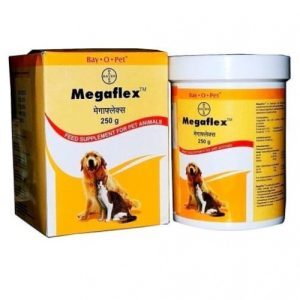Table of Contents
Megaflex by Bayer is a versatile dietary supplement designed for both cats and dogs. This supplement is suitable for pets of all ages and is crucial in promoting and maintaining bone health. Megaflex from Bayer is specifically produced to bolster and aid in recovering joints, cartilage, and tendons, effectively enhancing your pet’s overall mobility.

What Is Megaflex?
If your beloved pet displays signs of a stiff gait, struggles to rise from a lying position, avoids jumping, or hesitates when tackling stairs, these symptoms could indicate musculoskeletal issues. Try Bay-o-Pet Megaflex dietary supplement – a meticulously balanced and premium-quality joint supplement infused with targeted nutrients. Its natural constituents are designed to invigorate your pet’s musculoskeletal system, particularly fortifying cartilage and joints.
This exceptional supplement harnesses the power of ingredients such as mussel meat meal, renowned for its abundance of glycosaminoglycans, which have a profoundly positive impact on joint health. Furthermore, the gelatin hydrolyzate present in this product actively supports cartilage formation.
Megaflex is suitable for pets at every stage of life, whether they are energetic youngsters or wise seniors, making it an ideal choice to ensure the well-being of both dogs and cats.
Ingredients
This product combines vegetable oils and supplementary plant-based ingredients, including willow bark, stinging nettle leaves, New Zealand green-lipped mussel, devil’s claw, vitamin E, omega-3, and omega-6.
Dosage Sizes
This daily supplement can be mixed with your pet’s food or administered directly in precise portions. The provided suggestions are for reference purposes only, and it is advisable to consult your veterinarian before giving it to your pet.
|
Pet Weight (kg) |
Daily Dosage (gm) |
|
Dogs up to 10 |
4 |
|
Dogs 10 – 20 |
6 |
|
Dogs above 20 |
8 |
|
Cats up to 5 |
2 |
|
Cats above 5 |
4 |
Important Safety Information for Pet Owners
We understand the importance of your pet’s well-being and want to provide you with essential safety information regarding using Megaflex. Please take note of the following precautions and guidelines to ensure the safety and health of your beloved furry companion.
Before starting any dietary supplement, including Megaflex, it is crucial to consult your veterinarian. Your vet can evaluate your pet’s specific needs and underlying health conditions and recommend the appropriate dosage.
Adhere strictly to the recommended dosage instructions based on your pet’s weight. Stay within the prescribed amount, as this can lead to unintended consequences.
Keep a watchful eye on your pet after administering Megaflex. Observe for any unusual behavior, allergic reactions, or adverse effects. If you notice anything concerning, discontinue use and contact your veterinarian immediately.
Be aware of any known allergies your pet may have to ingredients in the supplement. If your pet is allergic to any components in Megaflex, discontinue use immediately.
Inform your veterinarian about any other medications or supplements your pet takes. Megaflex may interact with certain drugs, and your vet can advise on compatibility.
If your pet is pregnant, nursing, or breeding, consult your veterinarian before using Megaflex, as their nutritional requirements may differ.
Consider your pet’s age, overall health, and any preexisting medical conditions when considering Megaflex. It may not be suitable for all pets.
Regularly schedule follow-up appointments with your veterinarian to assess your pet’s response to Megaflex and make any necessary adjustments.
Veterinary Prescription
Megaflex by Bayer is typically available as an over-the-counter dietary supplement for pets. It does not require a veterinary prescription for purchase.
However, pet supplements’ availability and regulations can vary by location and may change over time. To ensure the most accurate and up-to-date information regarding the purchase of Megaflex in your area, we recommend checking with your local pet supply stores and pharmacies or contacting Bayer directly. They can provide information on your pet’s current requirements for obtaining Megaflex. Additionally, consulting your veterinarian is always a good practice to determine if Megaflex suits your pet’s needs.
Interactions
Megaflex is a dietary supplement commonly used to support joint and musculoskeletal health in pets. While it’s generally considered safe when used as directed, it’s essential to be aware of potential interactions with other medications or supplements your pet may be taking. Here are some considerations:
- Non-Steroidal Anti-Inflammatory Drugs (NSAIDs): If your pet is already taking NSAIDs for pain or inflammation, adding Megaflex may increase the risk of gastrointestinal issues or other adverse effects. Always consult with your veterinarian before combining supplements with NSAIDs.
- Blood Thinners: Some ingredients in Megaflex, such as omega-3 fatty acids, may have mild blood-thinning properties. If your pet is on blood-thinning medications, consult your veterinarian to monitor clotting times and adjust dosages as needed.
- Other Supplements: Discuss potential interactions with your veterinarian if your pet is taking other dietary supplements, especially those containing similar ingredients like glucosamine or chondroitin. They can help determine the appropriate combination and dosage.
- Prescription Medications: If your pet is on any prescription medications, inform your veterinarian about the use of Megaflex to ensure there are no contraindications or interactions that could affect your pet’s health.
- Allergies: Be aware of any known allergies your pet may have to the ingredients in Megaflex. Allergic reactions can occur, so monitor your pet closely after starting the supplement.
- Health Conditions: Consider your pet’s overall health and any preexisting medical conditions. Megaflex may not be suitable for all pets, especially those with specific health issues.
It’s crucial to consult your veterinarian before starting any new supplement regimen for your pet, including Megaflex.

Side Effects
Megaflex is a dietary supplement commonly used to support joint and musculoskeletal health in pets. While it’s generally considered safe when used as directed, there is the potential for side effects, although they tend to be rare and mild. It’s essential to monitor your pet closely when starting any new supplement and consult your veterinarian if you notice any adverse reactions. Possible side effects of Megaflex may include:
- Gastrointestinal Upset: Some pets may experience mild digestive upset, such as diarrhea, vomiting, or flatulence when first introduced to Megaflex. This is usually temporary and can often be resolved by adjusting the dosage or administering the supplement with food.
- Allergic Reactions: In rare cases, pets may exhibit signs of an allergic reaction to one or more ingredients in Megaflex. Symptoms can include itching, hives, swelling of the face or paws, or difficulty breathing. If you suspect an allergic reaction, discontinue use and seek immediate veterinary attention.
- Change in Appetite: Some pets may experience changes in appetite, either an increase or decrease when taking Megaflex. Monitor your pet’s eating habits, and consult your veterinarian if you have concerns.
- Behavioral Changes: Although less common, some pet owners have reported changes in their pet’s behavior, such as increased restlessness or lethargy. If you notice significant behavioral changes, consult your veterinarian.
- Blood Thinning: Megaflex may contain ingredients like omega-3 fatty acids with mild blood-thinning properties. If your pet is prone to bleeding disorders or is on blood-thinning medications, consult your veterinarian to monitor clotting times.
- Interactions with Other Medications: Megaflex may interact with other medications your pet is taking. Always inform your veterinarian of all the supplements and medications your pet is using to avoid potential interactions.
It’s essential to introduce Megaflex gradually, follow the recommended dosage instructions, and monitor your pet for unusual reactions. If you notice persistent or severe side effects, discontinue using Megaflex and consult your veterinarian for further guidance.
Overdose
An overdose of Megaflex or any dietary supplement can harm your pet. Megaflex is typically formulated with specific dosage recommendations based on your pet’s weight and needs. If you suspect that your pet has ingested an excessive amount of Megaflex, here are some steps to take:
- Contact Your Veterinarian: Reach out to your veterinarian immediately for guidance. Please provide them with details about the product, the estimated amount ingested, and your pet’s weight and condition.
- Observe Your Pet: Keep a close eye on your pet for any signs of adverse reactions or distress. Overdose symptoms may include vomiting, diarrhea, lethargy, difficulty breathing, or other unusual behavior.
- Follow Veterinarian’s Instructions: Your veterinarian will provide specific instructions based on your pet’s condition. They may recommend inducing vomiting or administering other treatments as necessary to mitigate the effects of the overdose.
- Seek Emergency Care: In severe cases, or if your veterinarian advises it, seek immediate emergency veterinary care for your pet.
Preventing an overdose is crucial, so always store Megaflex and other supplements out of your pet’s reach in a secure location. Additionally, strictly adhere to the recommended dosage instructions provided on the product packaging or by your veterinarian.
Storage
Store Megaflex in a cool, dry place. Avoid exposure to direct sunlight or extreme temperature fluctuations. A temperature-controlled environment is ideal to prevent the degradation of the product. Do not store Megaflex in humid or damp areas, as moisture can lead to clumping or spoilage of the product.
Ensure that the container or packaging is sealed tightly after each use. This helps prevent moisture and air from getting inside, which can affect the quality of the supplement.
Store Megaflex out of reach of pets and children. This prevents accidental ingestion and maintains the product’s integrity. If you have small children or pets, consider using childproof storage containers or placing Megaflex in a secure cabinet to prevent accidental access.
Check the expiration date on the product label, and do not use Megaflex if it has expired. Expired supplements may be less effective, and their safety could be compromised.
Whenever possible, store Megaflex in its original packaging. The manufacturer typically designs the packaging to protect the product from external factors.
FAQ
What are the key ingredients in Megaflex?
Megaflex typically contains a combination of ingredients like glucosamine, chondroitin, omega-3 fatty acids, and other nutrients to promote joint health.
Is Megaflex safe for all pets?
Megaflex is generally safe for most pets, but it’s essential to consult your veterinarian before starting any supplement regimen, especially if your pet has underlying health conditions.
How is Megaflex administered to pets?
Megaflex is usually available in a palatable form that can be mixed with pet food or given directly. Dosage instructions vary based on your pet’s weight and needs.
Can Megaflex be used as a preventive measure, or is it only for pets with existing joint issues?
Megaflex can be used both preventively and as a treatment for pets with joint issues. Please consult your veterinarian for guidance on its suitability for your pet.
Can Megaflex interact with other medications or supplements?
Yes, Megaflex can interact with certain medications and supplements. Always inform your veterinarian about all the products your pet is using to avoid potential interactions.
How long does it take to see results when using Megaflex?
The time it takes to see results can vary depending on your pet’s condition. Some pets may experience improvement in a few weeks, while others may take longer. Consistency in administration is essential.
Can I adjust the dosage of Megaflex for my pet?
Dosage should be based on your pet’s weight and the recommendations provided on the product packaging or by your veterinarian.

































